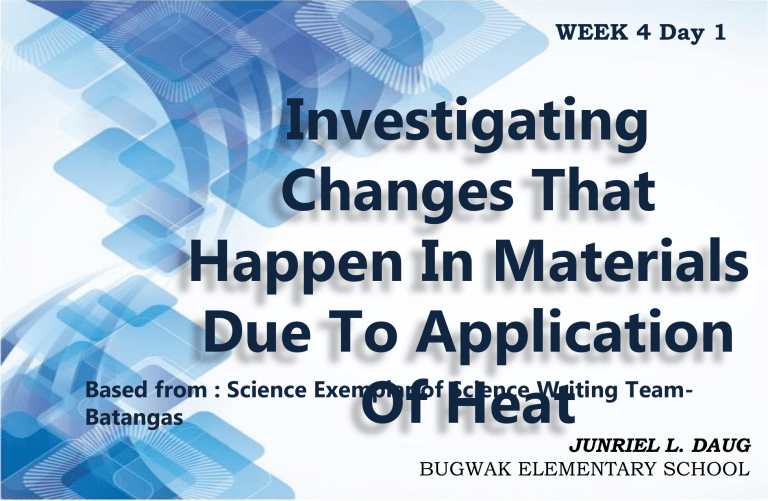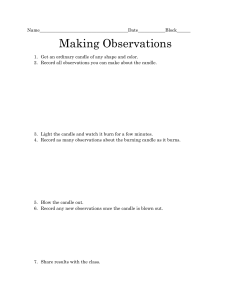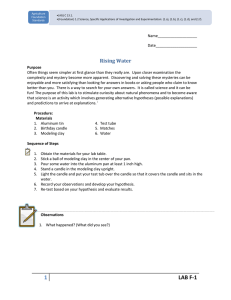
WEEK 4 Day 1 Investigating Changes That Happen In Materials Due To Application Of Heat Based from : Science Exemplar of Science PRECILAWriting R. UMALI TeamJose Zavalla Memorial E/S Batangas JUNRIEL L. DAUG BUGWAK ELEMENTARY SCHOOL Engageme nt Distribute the pieces of scratch paper to the class. Ask them to manipulate it to show physical change through: Folding Cutting Crumpling Tearing Engageme nt Perform a simple demonstration of burning paper. Note: Collect the papers after the activity. Engageme nt 1.What happened to the scratch paper? 2.What changes did you observe? 3.Can you return the ash into a scratch paper? 4.Why or Why not? Exploratio n Predict what will happen if we heat white sugar in a pot. Fill up the chart below. What happen to the sugar inside the pot when heated? What I know What I want to What I Know learned Exploration Activity What you need: 2 tablespoons of white/refined sugar pot spoon,Stove/alcohol lamp/candle Procedure: 1. Pour 2 tablespoons of sugar in a pot. 2. Turn on the stove and heat the sugar in low fire. Caution: Be very careful when heating the sugar. The teacher may assist on this part. Do not taste it. 3. Observe what happened. 4. Turn off the stove when the sugar is about to melt. 5. Record your observations on the chart below. Exploratio Activity n Characteristics Before Heating After Heating color state/phase odor Explanation Group Reporting 1.Did the sugar change its color? Describe it. 2. Did its phase change? 3. What are the indications that the sugar really underwent chemical change? 4. Is there a new product formed? 5. What were the changes that occur in sugar due to application of heat? 6. Are your predictions correct? Elaboration 1.What is chemical change? 2.What are the indications of chemical change? A chemical change occurs to materials when heat is applied. Change in color, taste and odor, production of smoke, ash, bubbles, fire, new products and even heat are the indications of chemical change. Elaboration 1.Is formation of bubbles indication of chemical change? an 2. When burning a paper, what are the new products formed? Evaluation Write the letter of the correct answer 1. Aling Maring burns leaves early in the morning in their backyard. Which of the following is the indication that material formed into new form when heat is applied on it? A.ash C. heat B. fire D. smoke Evaluation Write the letter of the correct answer 2. Which of the following procedures in cooking banana cue involves chemical change? A. peeling the bananas B. melting the sugar C. putting the bananas on the sticks D. selling the banana cue Evaluation Write the letter of the correct answer 3.Ash is a new substance formed when ________. A. pyrite comes into contact with acid. B. food is digested. C. a fruit turns moldy. D. wood is formed. Evaluation Write the letter of the correct answer 4. Which of the following activities showed chemical change due to application of heat? A. pancake making B. cutting of wood C. straightening of hair D. rusting of nail Evaluation Write the letter of the correct answer 5. Which of the following is NOT an indication of chemical change due to application of heat? A. change in color B. change in odor C. change in taste D. change in size Thank You! WEEK 4 Day 2 Signs When Materials Undergo Physical And Chemical Change Due To Presence/Lack of Oxygen Based from : Science Exemplar of Batangas PRECILA R. UMALI Jose Zavalla Writing Memorial E/S Science Team- JUNRIEL L. DAUG BUGWAK ELEMENTARY SCHOOL Engageme Identify the materials that undergoes nt as shown change chemical Engageme Identify the materials that undergoes nt as shown change chemical Engageme Identify the materials that undergoes nt as shown change Photosynthesis chemical Ripening of fruit Exploratio Activity n : Give Me the Signs What you need: candle candle holder matchstick glass apple bowl of water Exploratio Activity n : Give Me the Signs What to do: 1. Put the candle in a candle holder. 2. Light up the candle. After a minute, observe the physical and chemical changes that happen to the candle when air is present. 3. Cover the lighted candle with a glass. 4. Observe what happened to the candle after covering it with a glass. 5. Slice the apple into halves. 6. Expose the first half of the apple into the air for few minutes 7. Soak the other first half in a bowl of water Exploratio Recording the observation n Material lighted candle sliced apple Change that Happen to Material When Oxygen is Present (lighted candle uncovered; sliced apple exposed to air) Change Happen to Material When Oxygen is absent (lighted candle covered; sliced apple soaked in water) Explanatio Guide Questions n 1.What have you observed from the burning candle when it is uncovered and covered? 2. What helped the candle continue burning? Explain your answer 3. What changes took place in the candle? 4. What happened to the sliced apple exposed to the air and soaked in water? 5. What changes took place in both of the halves of the sliced apple? 6. What physical change(s) occurred? 7. What chemical change(s) occurred? 8. What condition contributed to these changes? 9. Have you observed rusting of iron window grills, why do you think this change occur? 10. To what elements are iron window grills exposed to? 11. What do you think are the reasons of rusting? Elaboratio n Can you enumerate signs when materials undergo physical and chemical change due presence of oxygen? How about the signs when materials undergo changes due to lack of oxygen? Elaboratio n Materials undergo chemical change in different ways. During the change process, one or more new materials with different compositions can be formed. For the chemical reaction to happen heat energy or other substances are needed to break the bonds of molecules. The speed rate of chemical reaction in different materials depend on temperature, presence of light, pressure, and presence of catalyst, and electricity. Evaluatio n Identify the sign when materials undergo change in each of the following situation below: 1. Aling Juana is a banana cue vendor. One time, she asked her daughter to help her peel the banana. It took them an hour to finish the task. She found out that all the peeled banana on the plastic tray turned into brown. Evaluatio n 2. Father found a dead rat inside the stock room. The decomposed body of the rat produced unpleasant odor. He disposed it by burying the remains into the soil. 3. Yaya Meling left the glass of bottle of milk on the table. The next morning she found out that there were bubbles formed. Evaluatio n 4.Gelyn went to Baguio for a vacation. She forgot to place her plants outside the garden. When she came back the plants were wilted. 5.Leftover soup was placed on a container for two days on the table. Bubbles formed because it is already spoiled. Assignme nt Answer the following questions: 1.Aside from camote, what other foods turns brown when exposed to air? 2.What will you do to leftover foods to avoid spoilage? Thank You! WEEK 4 Day 3 LESSON 18 Signs When Materials Undergo Physical And Chemical Change Due To Application of Heat Based from : Science Exemplar of Batangas PRECILA R. UMALI Science TeamJose ZavallaWriting Memorial E/S JUNRIEL L. DAUG BUGWAK ELEMENTARY SCHOOL Analyze each picture. Tell whether the change shown is physical or chemical change then enumerate the signs of change. 1. 2. Analyze each picture. Tell whether the change shown is physical or chemical change then enumerate the signs of change. 3. 4. Analyze each picture. Tell whether the change shown is physical or chemical change then enumerate the signs of change. 5. 6. Analyze each picture. Tell whether the change shown is physical or chemical change then enumerate the signs of change. 7. 8. Analyze each picture. Tell whether the change shown is physical or chemical change then enumerate the signs of change. 9. 10. Analyze each picture. Tell whether the change shown is physical or chemical change then enumerate the signs of change. 11. Arrange the jumbled letters to form the words which we will use in out activity later. The meaning of the words serves as your clue 1.OUBTSINCOIN - igniting or fire 2.ERETUTMEPRA - hotness or coldness 3.OOTS - dirt 4.PERISPIATTE - to become separated from a liquid 5.EVERRISLEB – able to be changed back to original form Activity Group activities Materials undergo change due to application of heat Problem: What are the signs of physical and chemical change due to application of heat? Materials: worksheet, matchstick, candles, empty tin can, ice, holder Procedure: 1. Light a matchstick until the half of the stick is burned. Observe what happens. 2. Light a candle. Using a holder, place an empty tin can over the flame of the candle. Notice what is formed at the bottom of the can. 3. Go outside. Put an ice anywhere. Leave it for 5 minutes. Observe what happens. Materials Matchstick Burning candle and tin can Ice What causes the materials to change? What is produce d? What are the signs that the materials undergo change? Can it be brought back to its original form? REPORTING 1.What caused the materials to change? 2.What happened to the matchstick when rubbed on a rough surface? 3. What made the material continue burning? 4. Was there an energy released while the matchstick is burning? 5. What energy was released? 6. Is there a new material formed? Can it be brought back to its original form? 7.What was formed at the bottom of the can? 8. What changes happened to the candle? 9. Can it be brought back to its original form? 10. How would you describe the ice before placing outside? 11. What happened to the ice after placing outside? 12. Was there a change in taste and color? 13. What change took place? Can it be brought back to its original form? What are the signs of physical and chemical change when heat is applied? Physical change Chemical change When a matchstick is rubbed against a rough surface, friction is produced. The matchstick is kindled. Its color changes into black. Smoke, heat and ashes are produced. These are new substances formed during combustion. They become irreversible. Soot or dirt is formed under the can when it is placed over the lighted candle. Heat is also transferred through conduction. Both the burned matchstick and ash on the heated tin can are products of chemical change. In placing the ice outside, its solid phase and shape becomes liquid. But no new material is formed. It is physical change. When heat is applied to materials that undergo physical change, they change in shape, texture, phase and temperature. On the other hand, when heat is applied to materials that undergo chemical change, color, odor and temperature also change. Identify the signs of change that are evident in each picture 1.Rough wood Identify the signs of change that are evident in each picture 2.Finished wood Identify the signs of change that are evident in each picture 3.Painting a car Identify the signs of change that are evident in each picture 4.Hot pan Identify the signs of change that are evident in each picture 5.Lighting a fireworks Draw pictures that exhibits signs of physical and chemical change. WEEK 4 Day 4 LESSON 19 When Materials Become Harmful To The Environment Based from : Science Exemplar of Science Writing TeamBatangas JUNRIEL L. DAUG BUGWAK ELEMENTARY SCHOOL Engagement Arrange the jumbled phrase to form the science ideas. Paste your work on the manila paper. where a new substance Chemical Change is a change in the composition may be formed. and characteristic of matter Engagement Let’s check it. Chemical Change is a change in the composition and characteristic of matter where a new substance may be formed. Engagement Arrange the jumbled phrase to form the science ideas. Paste your work on the manila paper. is a change only in the state of matter and is formed. no new material Physical Change . Engagement Let’s check it. Physical Change is a change only in the state of matter and no new material is formed. Engagement FACT OR BLUFF 1. Liquid freezes into solid such that you can hold water. FACT 2. Due to physical change, the sweet sugar may turn sour or bitter. BLUFF 3. To dry clothes, liquid evaporates into gas called water vapor. FACT 4. There is no new substance formed when carbon dioxide and water become food in the plant. BLUFF 5. Melting of candle is a change from solid to liquid. FACT Exploration Activity Where do I belong? Problem: Which situations show chemical change and physical change? Materials: table, chart Procedure: 1.Study the following situations. Classify in the proper table. 2.Classify changes that occur as to physical and chemical changes Exploration Activity Where do I belong? a. stretching a rubber band without breaking it. b. vegetable infected with pests. c. tissue paper being burned. d. breaking barbecue stick into 3 pieces. e. cutting a sheet of cardboard into 4. f. combining ammonia and vinegar. g. smoke produced while heating the sugar. h. food left outside the refrigerator gets spoiled. i. pounding a teaspoon of peanuts. j. bending a piece of wire to form a circle. Explanation Activity Record your answers in the table/chart below Physical Change Chemical Change Elaboration What is physical change? What is chemical change? Evaluation Classify the following changes in materials as to chemical or physical. ___1. Fruit juice becomes alcoholic drinks. ___2. A liquid turns into gas when it is heated. ___3. Banana turns sweet. ___4. Mother bakes your favorite cookies. ___5. Plastics and nylon stockings are made from organic material Thank You! WEEK 4 Day 5 LESSON 20 Specific Changes That Occur As To Physical And Chemical Change Based from : Science Exemplar of Science Writing TeamBatangas JUNRIEL L. DAUG BUGWAK ELEMENTARY SCHOOL Engagement Write “P” for Physical or a “C” for Chemical, to indicate the type of change that is taking place. _____1. digestion of food _____ 2. cutting of wood _____ 3. melting of butter _____ 4. ripening of fruits _____ 5. water evaporating Exploration What are the specific changes manifested by the materials during physical and chemical change? Physical Change Melting Freezing Evaporation Condensation Sublimation Deposition (solid to liquid) (liquid to solid) (liquid to gas) (gas to liquid) (solid to gas) (gas to solid) Exploration What are the specific changes manifested by the materials during physical and chemical change? Chemical Change Change in taste Change in color Change in odor Precipitation Effervescence or the formation of bubbles Exothermic and endothermic reactions Explanation Physical Change Melting(solid to liquid) is a physical process that results in the phase transition of a substance from a solid to liquid Freezing (liquid to solid) is a phase transition in which a liquid turns into a solid when its temperature is lowered below its freezing point. Explanation Physical Change Vaporization (liquid to gas) is a type of vaporization of liquid into a gaseous phase that is not saturated with the evaporating substance. The other type of vaporization is boiling, which is characterized by bubbles of saturated vapor forming in the liquid phase Condensation (gas to liquid) is the change of water from its gaseous form (water vapor) into liquid water. Generally occurs in the atmosphere when warm air rises, cools and looses its capacity to hold water vapor. Explanation Physical Change Sublimation (solid to gas) is the transition of a substance directly from the solid to the gas phase without passing through the intermediate liquid phase. Deposition (gas to solid) is the process in which gas transforms into solid. Explanation Chemical Change Change in color is tarnishing, rushing, and bleaching are example of changes in color that are indicative of chemical changes. Change in odor is putrefaction or decay of organic matter, a chemical change, is often accompanied by the formation of foul smell. Any changes in odor is almost always an indication of chemical change. Explanation Chemical Change Change in taste is the souring of milk and other edible substances are also an indication of chemical change. Effervescence or the formation of bubbles is the formation of bubbles from leaves of water plants is an indication of photosynthesis, a chemical change. The action of acids on metals and carbonates is also a chemical change that is characterized by effervescence. Explanation Chemical Change Precipitation is the formation of insoluble particles of solid may result from a chemical change. The cloudy suspension that results from the action or carbon dioxide on limewater is a chemical change Exothermic and endothermic reaction is the loss or gain of heat in most changes is often an indication of a chemical change. Elaboration 1. What are the specific changes manifested by the materials during physical change? 2. What are the specific changes manifested also by the materials during chemical change? Evaluation Below is a list of changes in matter. Under the Physical Change or Chemical Change. Identify the specific change column write PC if the material underwent Physical Change and CC if Chemical Change the occurs in each of the items listed. Process/Change 1. Cloud Formation 2. Make food flavor 3. Drying Clothes 4. Making ice cream 5. Rusting of roof Physical Change/Chemical Change Specific Change Assignment Answer the following questions. 1.What benefit can people can from the following situations? a. Evaporation of water b. Burning of wood c. Water into ice d. Solidified ice cream Thank You!





